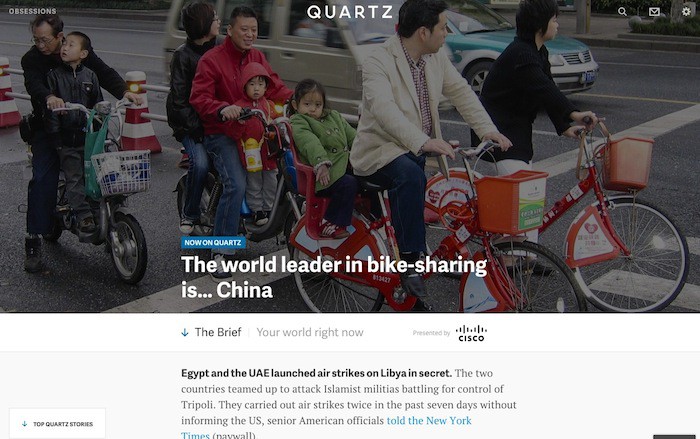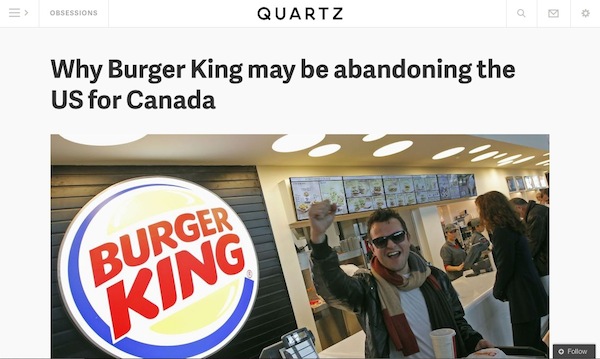
It was only a couple months ago that Quartz was making a bold proclamation: “The homepage is dead, and the social web has won.” The behavior of news consumers online was shifting rapidly away from the old way — going to a news site’s homepage, looking for an article that interests you — to one fueled by the streams of links found in social media.
This argument wasn’t a new one for Quartz, which launched two years ago without a traditional homepage. Type qz.com into your browser and you’d be thrown directly into the site’s top story. Rather than the usual back-and-forth of website navigation — homepage, click, back arrow, click again, back arrow — Quartz wanted you to scroll from story to story.So if you went to qz.com yesterday morning, you could be forgiven for being confused. With a new redesign that launched late Sunday, Quartz has gone retro and built an actual homepage. And they did it for the reason just about every other news site has a homepage — to build up reader loyalty.
But Quartz still has a twist. Rather than the usual arrangement of links to top stories, the new Quartz homepage is centered on The Brief, a tailored summary of business and international news under the rubric of “Your world right now.” (It’s also sponsored, currently by Comcast.) “It’s intended to be read straight through, like a well written memo from a trusted advisor,” Quartz senior editor Zach Seward wrote in a post announcing the site’s redesign. The Brief is modeled after Quartz’s successful email newsletter, The Daily Brief, which similarly offers quick hits of what readers need to know. But unlike the email, which is sent out every morning, the Brief will be updated regularly throughout the day.
“There’s something very convenient about getting something in your inbox that you want to be receiving on a regular basis,” said Seward, a former Nieman Lab staffer. “The one thing this isn’t is that — obviously you have to come to it instead of having The Daily Brief come to you, but they’re somewhat complementary and we expect that readers of one are likely to be readers of the other.”
Pre-redesign, 90 percent of visitors to Quartz’s website arrived through article pages, with just 10 percent coming through the qz.com front door. Part of that is Quartz’s focus on social distribution of its stories, the idea that every story starts with an audience of zero. But Seward said it’s also a chicken-and-egg scenario: “If you don’t build a homepage for people to go to, they’re not going to come to it.”

Any news site aims to build up user loyalty. For most, that means return visits to the homepage, but Quartz found an unusual route to habit-building through its daily email, which gets open rates north of 40 percent. The new homepage approach merges the two. Quartz doesn’t expect the shift to significantly change the percentage of visits that start on the homepage; rather, Seward said the site hopes to grow overall audience while creating an experience that will encourage users to stay longer on Quartz.

“The intended use of [The Brief] is loyal return visits. We need to gauge whether we see that happening at all, and then at what frequency.” Seward said. “The frequency is less about measuring the success of it — frankly, I actually think we don’t know yet. It’s so new, and there aren’t enough analogous products out there to really tell if we should be expecting people to just be twitchy and checking it all the time, or if they have one time in their day when they check it and it’s just that once a day. That’ll inform what we should be doing with the writing of the briefs in the first place.”
The Brief also takes a cue from Glass, a subsite Seward launched earlier this year that focuses on television. Headlines on Glass are presented in an outline format where users can click on them to get more information or added context that drops down. Quartz has taken the same approach on the Brief, with arrows you can click on to get more information about some stories.Beyond the front page, the redesign cleans up what was already a relatively uncluttered site by news standards, stripping out clutter. Article pages now give even more room for visuals. The old look featured a menu of other Quartz stories, internally called the queue, on the left side of the page; that’s gone now, with users needing to click a hamburger button in the top left corner of the page to make it appear. Only 20 percent of readers who went onto read a second story on the site used the queue, Seward said. The rest just utilized Quartz’s continuous scroll which brings up the next story at the end of the current one you’re reading.

As has been true since its launch, Quartz is designed primarily for mobile devices. Initially, the primary target was the tablet, then ascendant, but phones have been persistently more popular in its traffic logs, so smaller devices were the focus on this redesign. (Seward noted that the distinction between tablets and phone is decreasing as phone screens continually increase; new iPhones with 4.7″ and 5.5″ screens are due on Sept. 9.)
This was the first time one of Quartz’s redesigns have been done in-house, its previous two iterations were designed with the assistance of outside firms. Other new features include new pages for obsessions, topics Quartz has taken a particular interest in covering, as well as new presentations for charts and graphs.
Quartz’s business side was intimately involved throughout the redesign process, publisher Jay Lauf told me, noting that many of the ways the redesign will benefit the editorial staff will also be a boon for advertisers. Quartz previewed the new site to advertisers, and Lauf said their reaction was “overwhelmingly positive.”

Quartz doesn’t run traditional banner ads, instead offering what it calls Engage ads, which appear as you scroll between stories, and Bulletins, its name for sponsored content. As part of the redesign, native ads on Quartz will have access to all the changes the site is implementing, and Engage ads now stretch to the edge of the page. They’re also three times as large as they used to be on smartphones, Lauf said.
“The increase in real estate tries to leverage the functionality of these devices that sort of foster interaction when the content presents itself well,” Lauf said. “People who use their phones love to tinker with tapping and swiping and just exploring things that are interesting to them. It’s hard to do that in small chunks of real estate.”